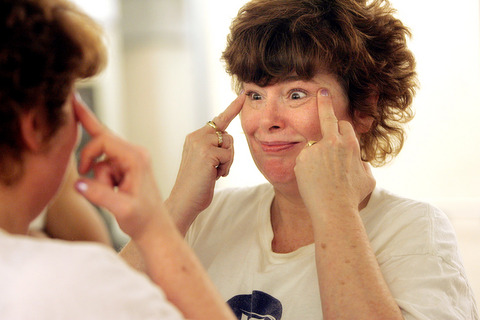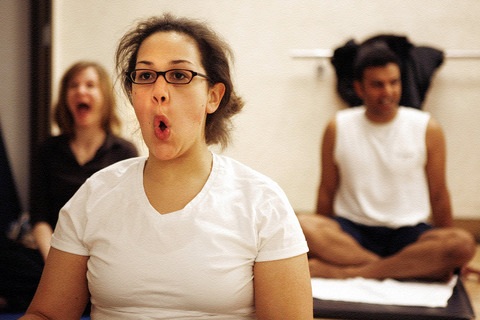For a Friday evening, the small, intimate workout room at the New York Health & Racquet Club on East 57th Street was comfortably full. A dozen people sat, their chins pointed toward the ceiling, their lips puckered as if preparing for a kiss.
Later, they took their index and middle fingers and tapped their mouths five times, with the hope of increasing lip fullness and color. If done each day, they were told, it would be just as if they had been injected with collagen.
"The resistance is what firms the muscles," Annelise Hagen, the teacher, said of Revita-Yoga, which combines yoga and facial exercises and is billed as a way to combat frown lines, wrinkles and sagging. "Each pose, stretch or exercise is designed to relax the muscles and release the patterns people unconsciously etch into their skin."

PHOTOS: NY TIMES NEWS SERVICE
Want to sculpture and narrow your nose? Alternate breathing out of each nostril, Revita-Yoga teaches. Have crow's-feet? Open the eyes wide to smooth the lines. As pale as the winter sky? A dose of downward dog can add color to the complexion while oxygenating the skin.
In an era when aging is treated as a disease and yoga is often touted as a cure-all, it is hardly surprising to see people combining the two. Classes are sprouting up all over the US and so are books, marketed to the portion of the population that wants the benefits of the knife and the needle without the costs or the risks.
That it works is unlikely, say doctors who specialize in skin or facial physiology. But it does relax practitioners while playing into their desire to do something about perceived flaws in their skin.

"People want a healthy alternative to looking good without artificial substance," said Hagen, a former actress whose book, The Yoga Face, is to be published this August by Avery, the health and wellness division of Penguin. "And they want to be in control of their appearance rather than relegating it to an authority. I'm teaching my students to consciously release muscles rather than paralyzing them, which is what Botox does."
The idea of merging exercise and beauty is not new. Beauty magazines have long carried how-to articles on firming up the face. But the concept seems to have become imbued with new energy in the last year.
Frownies and jowlies are under attack at the Lake Austin Spa Resort in Austin, Texas, where guests are led through a series of 23 facial movements meant to release facial tension, lift droopy mouth corners and iron forehead wrinkles.

The Kapiolani Health Center in Honolulu, Hawaii, has six two-hour sessions designed to create "balanced facial symmetry" while revitalizing and rejuvenating skin.
Gary Sikorski, who is certified in yoga facial toning, gives his Happy Face workshop in the Atlanta area. In a phone interview, Sikorski sounded, well, quite happy. He had just seen a graduate of his course, and, he said, "she had been practicing a lot on her own, and she looked amazing! The corners of her mouth were turned up, she looked younger and was absolutely glowing."
The latest six-session series, he said, drew 25 seekers of his guidance for stimulating 57 muscles in the face, neck and scalp. Sikorski sent them home with a 33-page booklet, a CD and fact sheets on nutrition and vitamins. "Folks are realizing the face has muscles and that there's a substitute to plastic surgery that costs less and can achieve similar results," he said.
Much less: At US$250, his class is a bargain when compared with a laser peel, which runs around US$600.
The publishing industry has been quick to sit up straight, breathe deeply and take notice. Besides Hagen's book, there is The Yoga Facelift, by Marie-Veronique Nadeau, coming out next month. Published by Red Wheel Weiser/Conari Presso, it will have a first printing of 15,000 — large for a small publisher in San Francisco.
"Plastic surgery can leave people looking like waxed fruit and doesn't address long-term sagging," said Nadeau, 59, whose workshops at Elephant Pharmacy, an alternative pharmacy chain in the Bay Area of Northern California, draw a standing-room-only crowd. "For some reason we exercise every part of our body but ignore everything from the collarbone up."
Maryann Donner, the group fitness director at New York Health & Racquet, said Hagen's Revita-Yoga class is part of another trend she has observed while organizing the 600 classes the chain's 10 gyms offer each week. "Right now the trend in classes is fusion, the bringing of two worlds together," Donner said.
For Revita-Yoga, "Annelise took her knowledge of facial exercises from her acting background and fused it with her yoga teachings," Donner said. "When she came to me last year with the idea, I fell in love with it immediately."
The class was called Yo-Tox until the folks from Botox had other thoughts. The club soon changed the name.
But is there any merit to these exercises, and will there ever be a substitute for freezing a muscle?
"Nothing is going to have a lasting benefit like Botox or filler or collagen injections," said Dennis Gross, a Midtown Manhattan dermatologist, the author of Your Future Face and the creator of a skin-care line. But there are short-term improvements, he said.
"Facial stretches and yoga temporarily reduce the neurological impulses associated with stress and the grimaces that lead to the lines in your forehead," he said. "The plumping of your lips is more a massage and only adds color for a few minutes."
And once the foot hits the pavement during rush hour, or the BlackBerry is back in hand, the face automatically tenses up, and the benefits of deep breaths and relaxation wear off.
"If you already have a wrinkle or a frown line, relaxation isn't going to erase that," said Richard Elias, an oral and maxillo-facial surgeon on the Upper East Side.
On the other hand, Elias said, there is no physical downside to facial workouts. And, he added, the exercises might help with prevention.
"Jowls, sagging under the neck, creases at the mouth, are all signs of aging that most probably will not be helped by a yoga class," he said. "If you make the muscles in your face bigger it will not make sagging skin tougher or tighter, nor will it help remove fatty deposits. Only a face-lift can do that. When you do a face-lift, you're removing fat and loose skin, and pulling some skin back."

June 23 to June 29 After capturing the walled city of Hsinchu on June 22, 1895, the Japanese hoped to quickly push south and seize control of Taiwan’s entire west coast — but their advance was stalled for more than a month. Not only did local Hakka fighters continue to cause them headaches, resistance forces even attempted to retake the city three times. “We had planned to occupy Anping (Tainan) and Takao (Kaohsiung) as soon as possible, but ever since we took Hsinchu, nearby bandits proclaiming to be ‘righteous people’ (義民) have been destroying train tracks and electrical cables, and gathering in villages

Dr. Y. Tony Yang, Associate Dean of Health Policy and Population Science at George Washington University, argued last week in a piece for the Taipei Times about former president Ma Ying-jeou (馬英九) leading a student delegation to the People’s Republic of China (PRC) that, “The real question is not whether Ma’s visit helps or hurts Taiwan — it is why Taiwan lacks a sophisticated, multi-track approach to one of the most complex geopolitical relationships in the world” (“Ma’s Visit, DPP’s Blind Spot,” June 18, page 8). Yang contends that the Democratic Progressive Party (DPP) has a blind spot: “By treating any

This year will go down in the history books. Taiwan faces enormous turmoil and uncertainty in the coming months. Which political parties are in a good position to handle big changes? All of the main parties are beset with challenges. Taking stock, this column examined the Taiwan People’s Party (TPP) (“Huang Kuo-chang’s choking the life out of the TPP,” May 28, page 12), the Democratic Progressive Party (DPP) (“Challenges amid choppy waters for the DPP,” June 14, page 12) and the Chinese Nationalist Party (KMT) (“KMT struggles to seize opportunities as ‘interesting times’ loom,” June 20, page 11). Times like these can

Swooping low over the banks of a Nile River tributary, an aid flight run by retired American military officers released a stream of food-stuffed sacks over a town emptied by fighting in South Sudan, a country wracked by conflict. Last week’s air drop was the latest in a controversial development — private contracting firms led by former US intelligence officers and military veterans delivering aid to some of the world’s deadliest conflict zones, in operations organized with governments that are combatants in the conflicts. The moves are roiling the global aid community, which warns of a more militarized, politicized and profit-seeking trend